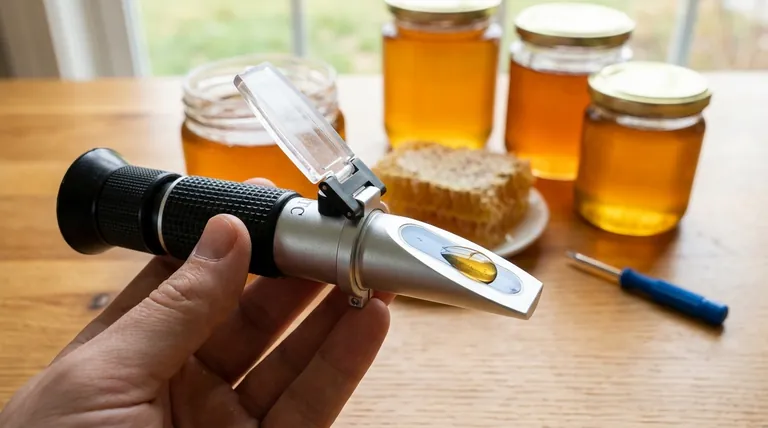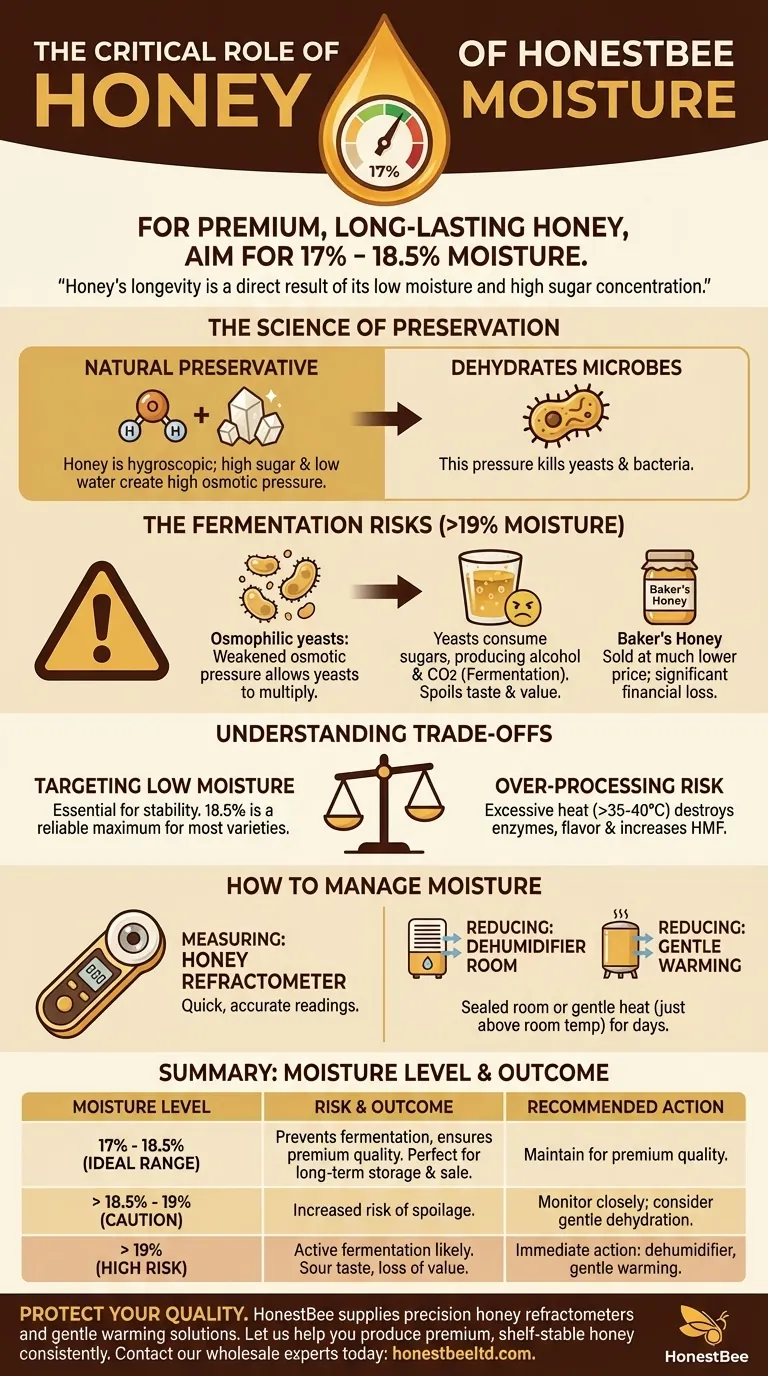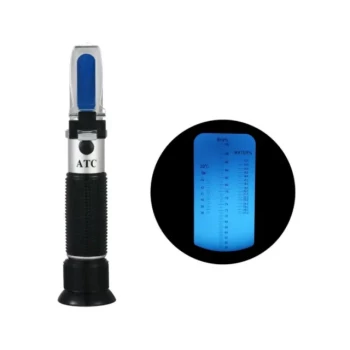For premium, long-lasting honey, the ideal moisture content is between 17% and 18.5%. This specific range is critical for preservation because it creates an environment too hostile for the yeasts that cause fermentation. Exceeding this level, particularly going over 19%, significantly increases the risk of your honey spoiling.
Honey's longevity is not an accident; it's a direct result of its low moisture and high sugar concentration. Mastering the moisture content is the single most important factor in preventing fermentation and preserving the honey's quality, taste, and value.

Why Moisture Content is a Critical Quality Factor
The moisture level in honey is the primary variable that determines its stability and shelf life. While bees work to dehydrate nectar naturally, environmental factors or premature harvesting can result in honey with excess water.
The Science of Preservation
Honey is hygroscopic, meaning it can absorb moisture from the air. Its natural state of low water content and high sugar concentration creates high osmotic pressure.
This pressure effectively dehydrates and kills microbes like yeast and bacteria, acting as a natural preservative.
The Fermentation Threshold
When moisture content rises above 19-20%, the osmotic pressure weakens. This allows naturally present osmophilic yeasts to multiply.
These yeasts consume the honey's sugars, producing alcohol and carbon dioxide, a process known as fermentation. This process irreversibly spoils the honey.
Impact on Quality and Taste
Fermented honey develops a sour, "off" taste and a bubbly or frothy appearance. It is no longer suitable for sale as premium table honey.
This spoilage not only ruins the complex flavor profile but also significantly reduces the honey's commercial value.
Understanding the Key Trade-offs
While targeting low moisture is essential, the process isn't without its own set of considerations. Simply removing water is only half the battle.
Not All Honey is the Same
Certain types of honey, due to their unique nectar source and chemical composition, can remain stable at slightly higher moisture levels than others.
However, treating 18.5% as a reliable maximum is the safest and most common industry practice for ensuring stability across almost all honey varieties.
The Risk of Over-Processing
To reduce moisture, beekeepers sometimes use gentle heat or dehumidifiers. However, excessive heat is detrimental.
Heating honey above 35-40°C (95-104°F) can destroy its delicate enzymes, degrade its flavor, and increase the levels of Hydroxymethylfurfural (HMF), an indicator of heat damage and aging.
"Baker's Honey" vs. Table Grade
If honey does ferment due to high moisture, it isn't always a total loss. It can often be sold at a much lower price as "baker's honey."
This grade is used in commercial baking where the off-flavors are masked by other ingredients, but it represents a significant financial loss compared to table-grade honey.
How to Manage Honey Moisture
Actively measuring and controlling moisture is a standard practice for ensuring a high-quality final product.
Measuring with a Refractometer
A honey refractometer is the essential tool for this task. It provides a quick and accurate reading of the moisture content, allowing you to know precisely where your honey stands.
Techniques for Reducing Moisture
If honey is harvested with a moisture content above 18.5%, it must be corrected. One common method is to place the honey in a sealed room with a dehumidifier.
Another option is to use a dedicated warming tank or bucket heater that gently heats the honey to just above room temperature, allowing excess moisture to evaporate over several days without damaging its quality.
Making the Right Choice for Your Goal
Your approach to moisture content should be dictated by your role and your objective.
- If your primary focus is producing premium, long-lasting honey: Aim for a final moisture content between 17% and 18.5% to guarantee stability and quality.
- If you have harvested honey with moisture above 19%: Take immediate action to reduce the moisture using a dehumidifier or gentle warming to prevent fermentation.
- If you are purchasing honey for resale or long-term storage: Always verify the moisture content is below the 18.5% threshold to protect your investment.
Controlling moisture is the definitive step that separates high-quality, shelf-stable honey from a product at risk of spoilage.
Summary Table:
| Moisture Level | Risk & Outcome | Recommended Action |
|---|---|---|
| 17% - 18.5% | Ideal Range: Prevents fermentation, ensures premium quality. | Perfect for long-term storage and sale as table honey. |
| > 18.5% - 19% | Caution: Increased risk of spoilage. | Monitor closely; consider gentle dehydration. |
| > 19% | High Risk: Active fermentation likely, leading to sour taste and loss of value. | Requires immediate action (dehumidifier, gentle warming) to salvage. |
Protect Your Honey's Quality and Your Bottom Line
For commercial apiaries and distributors, achieving the perfect moisture level is non-negotiable for protecting your product's value. HONESTBEE supplies the reliable equipment you need to ensure quality control, including precision honey refractometers and gentle warming solutions.
Let us help you produce and sell premium, shelf-stable honey consistently.
Contact our wholesale experts today to discuss the right equipment for your operation.
Visual Guide

Related Products
- Precision Honey Refractometer Instrument for Quality Assessment
- Professional Thermostatic Conical Honey Melter
- Stainless Steel Manual Honey Press with Guard for Pressing Honey and Wax
- Inverted Squeezable Honey Jar with No Drip Flip Top Cap for Easy Pouring
- electric honey extractor honey centrifuge 3 frame honey extractor stainless steel honey frame extractor
People Also Ask
- What are the key points for proper usage of a honey refractometer? Ensure Accurate Moisture Readings Every Time
- How does a honey refractometer work? Ensure Honey Quality & Harvest Readiness
- What are the features of the Standard Refractometer for honey moisture content? Essential Tools for Quality Control
- What is a honey refractometer and what is its purpose? Ensure Honey Quality and Prevent Spoilage
- What is a honey refractometer? The Essential Tool for Perfect Honey Quality



















